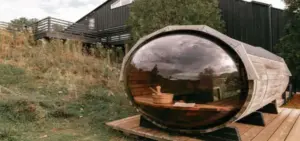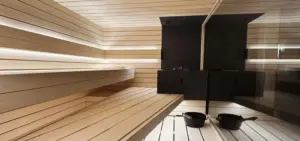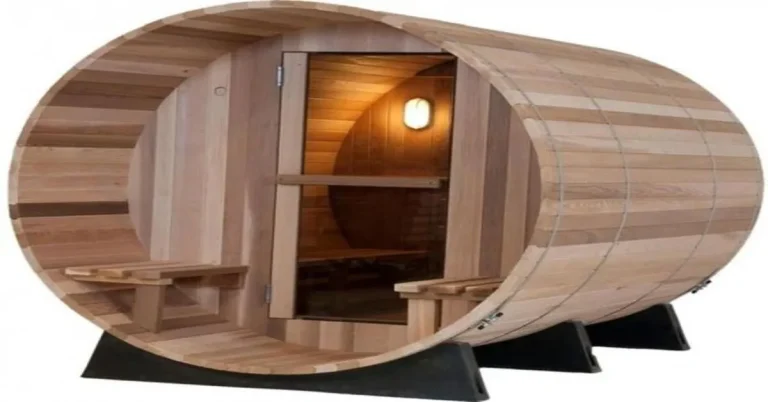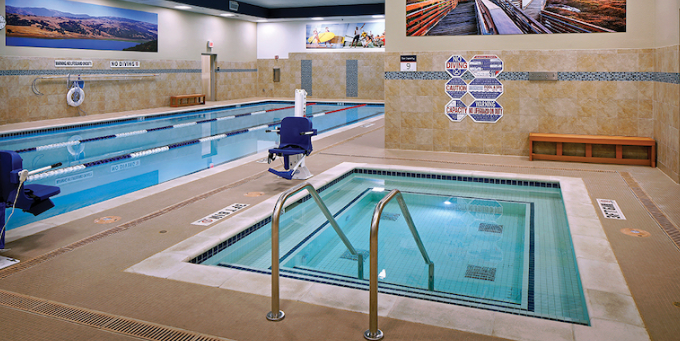Upon my experience with both types of saunas—indoor and outdoor—I discovered that although indoor saunas are more convenient and easily integrated into the home, outdoor saunas allow greater flexibility and a distinct connection to nature. In the end, the optimal option will rely on your tastes and the amount of room you have available.
Like designing your house or organizing a meal, selecting an indoor sauna is a matter of taste. There are many customization options available to let your cabin express your personality. Everything is up to you to choose from, including the form and style of the construction. One of the most important choices you’ll have to make is whether to build an outdoor or indoor sauna. We offer complete instructions in our website article to assist you in creating the ideal home sauna that suits your preferences.
Table of Contents
How Do Outdoor vs Indoor Saunas Differ From Each Other?
There are several advantages and disadvantages to compare between outdoor and indoor saunas, with location being the most important factor.
Outdoor saunas are typically located in backyards, close to lakes or pools. Because there are no restrictions on interior space and it is simpler to get enough ventilation, they offer more customization options. There are many different materials, designs, and sizes available for outdoor spas. These spas can blend in with swimming pools and landscaping as part of a wider backyard getaway.
Outdoor baths can be customized to improve the views of your surroundings and are not restricted by size, in contrast to indoor saunas. They can have windows, plastic bubble backs, or glass doors to optimize natural light. They are available in a variety of designs, including container, raindrop, and cabin styles.
Indoor saunas are built as either standalone appliances or as part of the home’s equipment. Home gyms, master baths, basements, and spa areas are typical places. Many choose to easily incorporate a unique spa into their newly constructed or renovated homes during construction. On the other hand, free-standing indoor saunas are flexible and mobile, making it possible to relocate and set them up as needed.
Outdoor Saunas

For individuals who would like to take advantage of the advantages of a sauna while being in the great outdoors, outdoor saunas are an excellent choice. The benefits and drawbacks of outdoor saunas are as follows:
Benefits:
The following benefits of outdoor saunas are given below:
- Exposure to the Elements: For individuals who enjoy spending time in nature, outdoor spas offer the special advantage of full participation in the outdoors and fresh air.
- Greater area: Unlike indoor saunas, outdoor types can be built to any size and aren’t limited by interior space requirements, providing greater areas for enjoyment and relaxation.
- Ease of Installation: A spa installed outside usually requires less professional help and ventilation, which makes the setup procedure easier.
Drawbacks:
The following drawbacks of outdoor saunas are given below:
- Maintenance Challenges: Because outdoor spas are exposed to the weather, they require more frequent cleaning and maintenance to stay in good condition than their indoor versions.
- Privacy Concerns: Because outdoor baths are open to the public and may be seen by neighbors or observers, they offer less privacy than inside spas.
There are unique benefits related to each style of hot tub, and in the end, the choice comes down to individual tastes and requirements.
Outdoor Sauna Types
Outdoor saunas come in a variety of sizes and designs, and they are unrestricted by inside space or ventilation requirements. A typical example is the Swedish tradition of the barrel spa, which can be improved with amenities like a glass bubble back allowing expansive views of the backyard.
The traditional cabin steam room, the sleek, raindrop-shaped Pod bath, and the gently curved Luna cabin are among the other well-liked options. To improve outdoor living spaces and cater to individual preferences, a lot of outdoor baths come with customizable features like glass doors, layered seating, exterior cooling chairs, and different exterior finishes.
Indoor Saunas

Indoor saunas are becoming more and more popular because of how practical and easy to use they are. The following are a few benefits and drawbacks of using an indoor spa:
Benefits:
The following benefits of indoor saunas are given below:
- Relaxed Location: Indoor saunas are easily accessible due to their comfortable interior locations. The installation of these can be flexible and might take place in parking lots, basements, or neglected spaces.
- Simplified Maintenance: Because indoor saunas are protected from the weather, they require less maintenance. For people who don’t have much time for maintenance, they require less regular cleaning and repair.
- Increased Privacy: Compared to outdoor saunas, indoor saunas offer more privacy. Day or night, they can be enjoyed without worrying about disturbing neighbors or drawing attention from outsiders.
Drawbacks:
The following drawbacks of indoor saunas are given below:
- Installation Difficulties: Setting up an indoor cabin might be difficult, especially if there isn’t enough room or ventilation. For correct installation and setup, expert help might be required.
- Space Restrictions: The amount of space that can be devoted to an indoor cabin depends on the size of the home. Installing a larger sauna may not be possible in small homes due to limits in size.
Indoor Sauna Types
With indoor saunas, you may create a customized bathhouse that fits into your house whether it’s being built from scratch or rebuilt. On the other hand, due to their convenience, premade kits are becoming more and more common. In areas like basements, home fitness centers, or master showers, these kits make it easy to put up a steam room.
PreFab indoor spa kits come in easy-to-install packaging that allows you to create a new cabin in only one afternoon. Choose from Prefab spas in the style of a cabin or models like the PreFab Pure Vision with an all-glass front, which both provide convenient luxury and a peaceful haven to home interiors.
Can you put an indoor sauna outside?
It is possible to place an indoor bath outside, but certain measures must be taken to guarantee its continued existence and functionality. Generally speaking, indoor spas are not designed to resist outside conditions such as wind, rain, or temperature changes.
You must provide sufficient weatherproofing, insulation, and moisture protection when converting an indoor spa to an outdoor setting. This can entail installing a roof for protection, waterproofing the outside, and making sure that electrical parts are securely insulated. To avoid weather-related damage, proper planning and upkeep of the site are also essential.
Factors for Selecting a Sauna
There are a few things to consider while choosing between an outdoor or indoor sauna:
- Location: First, decide on the best spot for the jacuzzi. While an outdoor spa benefits from plenty of room, an indoor spa may be more practical when there is little space inside.
- Size: The sauna’s dimensions should correspond to your needs for both space and use. While a larger bath can handle many users or large settings, a smaller cabin is more appropriate for tiny spaces.
- Cost: Because they don’t require as much infrastructure, indoor spas are usually less expensive. Even though they cost more, outdoor baths might be a wise purchase if you use them frequently and have enough room.
- Weather: Climate has an impact; in colder climates, indoor baths keep a constant temperature, while in warmer climates, outdoor baths provide comfort.
- Maintenance: Because they are protected from the weather, indoor baths often require less maintenance. Weatherproofing and routine cleaning are necessary for outdoor baths to last a long time.
You can select the cabin that most closely matches your tastes and way of life by taking these factors—space availability, cost, environment, and maintenance requirements—into consideration.
Design and Installation

Design
The design is a major factor in both practicality and visual appeal when choosing between an indoor and outdoor jacuzzi. The way the steam room blends into your house or balcony depends a lot on its design. Spas can be designed in a variety of ways. Steam rooms with barrel, raindrop, and cabin shapes are popular options.
Baths in the style of barrels are popular in outdoor settings, whereas baths in the shape of cabins are typically installed indoors. Steam rooms in the shape of raindrops provide a unique and modern appearance that can improve any home setting. Beyond the spa’s shape, take into account further design elements that can improve its modern vibe, including glass doors or plastic bubble backs.
The kind of wood used, the choices for flooring, and the features that can be customized are further design factors to take into account. When choosing a steam room, it’s crucial to make sure its style fits your tastes and matches your living area.
Installation
A sauna’s installation requires careful thought to guarantee its functionality, safety, and visual appeal. One important element that cannot be overlooked is ventilation, which is essential for both comfort and avoiding moisture buildup in the spa. Choosing the appropriate hammam kit is also crucial.
Selection of an infrared kit that fits your installation needs and capabilities is essential because infrared kits differ in terms of quality and simplicity of installation. A crucial factor to take into account is the selection of building materials. Materials like cedar wood, hemlock, and pine are frequently used in spas; each affects the materials’ endurance, durability, and overall appearance.
In conclusion, careful thought through design and installation aspects is necessary to ensure that your indoor or outdoor bathhouse not only satisfies safety regulations but also effectively improves the environment in your house or backyard.
Indoor sauna vs Outdoor sauna; What is best for your home?
Either an outdoor or indoor sauna will ultimately depend on your unique situation and the design of your property. Both alternatives can be modified to suit your needs, and the cost of purchase and installation is typically comparable. Outside steam rooms, however, frequently have a small advantage. They don’t take up interior space that may be utilized for more bedrooms or bigger bathrooms.
In addition, since they don’t need planning approval or complicated vapor barrier concerns, outdoor bathhouse installations are usually simpler. To sum up, although both indoor and outdoor spas provide benefits and customization, outdoor spas may be more flexible and convenient based on your tastes and the layout of your home.
Outdoor vs Indoor Saunas: Conclusion
The choice between an outdoor or indoor sauna ultimately comes down to personal taste. Weighing these considerations in light of individual demands and lifestyle preferences is crucial because each choice has unique benefits and drawbacks. Selecting an outdoor or indoor spa is a very personal choice. Some people like the ease and privacy of an indoor steam room, while others might prefer the true and organic atmosphere of an outdoor environment.
Making an informed decision requires careful evaluation of the benefits and drawbacks of each option. Whichever kind you choose, adding a steam room to your fitness routine can be very helpful. Choose the bathhouse that is most appropriate for you by taking the time to carefully consider your needs and preferences.
FAQs
The most frequently asked questions are given below:
Which is better, an indoor or outdoor sauna?
Indoor spas are an excellent option if you have extra space and desire total quiet. With outdoor spas, it is simpler to get an exact layout and design. While installing an outdoor spa is easier, maintaining an inside spa is easier.
Which type of sauna is healthiest?
Although both conventional and infrared saunas have many health advantages, infrared baths might be a better choice. More efficient core body temperature raising in infrared heat results in deeper detoxification and relaxed muscles.
Is an outdoor sauna worth it?
Relaxation and better circulation are just two of the many health advantages of spa use. You can still enjoy the healing heat of a conventional bathhouse while getting some fresh air. Parties and other social gatherings would be ideal in an outdoor hot tub, which may also be used as a gathering place.







